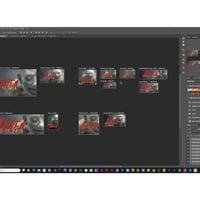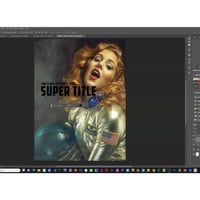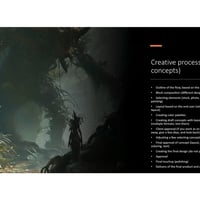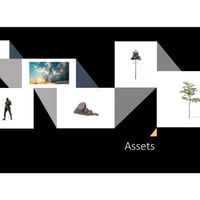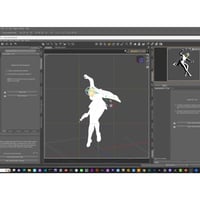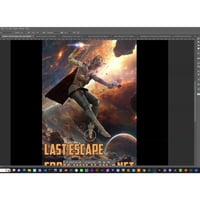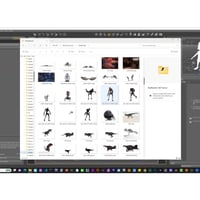-
-
 NEW
NEW
-
-
-
$64.99
Artist:Compatible Figures:N/ASKU:103031Optional License Add-Ons:
$1.99*Unless otherwise specified, no discounts or offers will apply to License Add‑Ons.
Optional License Add-Ons:
$1.99*Unless otherwise specified, no discounts or offers will apply to License Add‑Ons.
-
Details
In today’s visual-centric world, the power of design is undeniable – particularly when trying to gain attention in crowded marketplace.
Yet, so many aspiring artists and professionals grapple with creating designs that truly resonate, make an impact, or stand the test of time. You’ve likely faced the frustration of your artwork getting lost in the noise, or felt the sting of a design that doesn’t evoke the desired reaction.
Perhaps you’ve looked at iconic designs and wondered, “What’s their secret?“.
It’s a challenging journey, from conceptualising an idea to translating it into tangible design, especially in a market saturated with content. But imagine if you had the chance to delve deep into the world of design, guided by an industry expert, understanding those very principles that can transform your work from ordinary to stand-out.
This course by Vladimir Chopine is your gateway to bridging those gaps, addressing your pain points, and raising your design skills.
In this immersive course, you will delve into the art and design techniques that are key to crafting compelling promotional materials, with a special focus on elevating items for sale, including digital 3D model content for platforms like the DAZ 3D store. You’ll go beyond the foundational principles of poster and book cover design and gain mastery over advanced techniques that set your work apart in the marketplace. Our curriculum emphasizes practical, real-world applications, ensuring that every lesson is grounded in hands-on experience tailored for commercial success.
What Will I Learn?
The course focuses on digital design principles and how to use 3d applications (DAZ Studio), Photoshop (or GIMP) and photos to create stunning cover designs for all types of print and digital media, including social media.
- - Deep Dive into Iconic Designs:
- Explore and understand the elements that make designs like the “Jaws” movie poster or “Jurassic Park” book cover iconic. Discover the magic behind unforgettable designs and how to apply those principles to your own creations.
- - Master Top-Level Design Principles:
- A comprehensive study of 7 fundamental design principles including Hierarchy, Balance, and Color Theory. Dive into each principle with hands-on activities, understanding their significance in creating impactful designs.
- - Learning from Mistakes:
- Delve into flawed designs to comprehend where they went wrong. This section will enhance your critical eye, helping you to avoid pitfalls and create designs that truly stand out.
- - Crafting Perfect Covers, Posters and Promos for Social Media / eCommerce using 3D applications, Photoshop, Stock and Photographic elements:
- Understand the nuances of designing for specific media types. From foundational principles like simplicity to intricate elements like composition & lighting, refine your skills for genre-specific design.
- - Photoshop Mastery for Compositing:
- Learn advanced Photoshop techniques tailored for poster and cover designs. Dive deep into compositing, color matching, depth creation, and text integration to produce cohesive and stunning visuals.
- - Typography Brilliance: Fonts speak volumes.
- Acquire the skills to select, integrate, and enhance text in your designs, ensuring they convey the right message while remaining visually pleasing.
- - Transitioning to the Business World:
- Hear first-hand from Vladimir Chopine about navigating the design market, building client relationships, and turning your designs into profitable ventures. Equip yourself not just as a designer, but as a market-savvy professional ready to make a mark in the industry.
Course Requirements
- - PC or Mac with Adobe Photoshop installed. Optional alternative : GIMP.
- - Software to render artwork from 3D content such as DAZ studio
- - Basic knowledge of Photoshop
About the Instructor : Vladimir Chopine
Vladimir Chopine holds a Master’s degree (or its equivalent) in Marketing and has led a team of technologists at DSW ad agency, contributing to branding projects for renowned brands such as Intel, Iomega, Carrier, Marvel Studios and Kodak, among others. He is an acclaimed digital artist and photographer, with numerous awards to his name. In addition to owning and creating content for the training site Geekatplay Studio, he teaches on various platforms, including Udemy and Skillshare. His portfolio also includes a range of promotional and cover materials for movies, series, and publications.
See a selection of his commercial artwork HERE
What's Included and Features
- Mastering Commercial Design Video Course
- Session 0 (introductory session) : 1 hour 33 minutes (.MP4)
- 00:00 Mastering Commercial Design: Tips for Succeeding with Digital Media
- 00:06 The Impact of a Good Poster Design
- 00:13 Revolutionary Poster Designs of Metropolis, Flash and More - Identifying Your Target Audience
- 00:21 Design for Maximum Impact: Understanding Demographics, Color Schemes, Typography, Balance, and Legal Considerations
- 00:27 Getting Started in Poster Design
- 00:33 Exploring The Journey: Representing Stories Through Motion and Mode
- 00:39 Discovering the Last Voyage: How AI Helps Create Amazing Storytelling Concepts
- 00:53 Unleashing the Power of Color and Type in Design
- 00:55 How to Create an Eye Catching Design for Commercial Work
- 00:59 Exploring the Art of Crop Tool in Photoshop
- 01:06 Creating Effective Segmentation and Composition in Design
- 01:12 Finding Clients and Joining the Design Marketplace: A Guide to Succeeding with AI-Generated Content
- 01:18 Create Your Own 1950s Sci-Fi Themed Movie Poster
- 01:25 Unlock the Secrets of Professional Poster Design with Vladimir
- Session 1 :1 hour 40 minutes (.MP4)
- 00:00 Introduction to the course and emphasis on leveraging Vladimir Chopine's extensive experience in design.
- 00:05 Vladimir discusses the importance of understanding client needs and setting up effective workflows in design projects.
- 00:10 Examination of various design elements and principles, with a focus on creating a personal workflow for each participant.
- 00:15 Discussion about balancing client requirements and resource estimation in design projects.
- 00:20 Emphasis on securing contracts and creating design concepts for client approval.
- 00:25 Students are encouraged to share their business goals and objectives, leading to a discussion about target audience analysis in design.
- 00:30 Vladimir highlights the importance of understanding client needs in relation to resource management.
- 00:35 In-depth discussion on the necessity of having the right assets for design projects and the process of creating draft versions.
- 00:40 Participants discuss their experiences and goals, highlighting the value of understanding the design process from different perspectives.
- 00:45 Focus shifts to the significance of knowledge as a resource and various avenues for learning and improvement in design.
- 00:50 Discussion on personal branding and its importance in the design industry, along with strategies for self-promotion and marketing.
- 00:55 Importance of registering one's business and understanding the legal aspects of design work, such as copyright and licensing.
- 01:00 Insights into the various software and tools used in the design process, and how these contribute to the overall effectiveness of design projects.
- 01:05 Vladimir shares his approach to learning and adapting to different software, emphasizing the importance of continuous learning.
- 01:10 Exploration of the potential for generating income through personal assets and the use of tools like Daz Studio.
- 01:15 Discussion on the value of unique ideas and creativity in design, along with tips on overcoming creative blocks.
- 01:20 Importance of understanding and utilizing AI tools in the creative process, especially for generating initial ideas and concepts.
- 01:25 Exploration of various resources and tools available for designers, including different software options and their applications.
- 01:30 Discussion on the effective use of photography and 3D tools in design, and how these tools can enhance the creative process.
- 01:35 Vladimir shares insights on his personal experience with outsourcing certain business functions and the impact of outsourcing on efficiency.
- 01:40 Emphasis on understanding the financial aspects of design work, including pricing strategies and cost management.
- Session 2 : 2 hours 1 minutes (.MP4)
- 00:00 Introduction to the session on mastering commercial design, focusing on marketing strategies, refining business goals into an elevator pitch, optimizing workflows, and identifying resources and online profiles.
- 00:04 Discussion on understanding target markets, considering geographical, technological, and cultural aspects, and how different demographics and political factors influence marketing strategies.
- 00:08 Emphasis on the importance of not narrowing the market too much, the challenges of expanding into broader markets, and the significance of using the right tools and continuously updating them.
- 00:12 Insights into personal vs. studio branding, the process and challenges of rebranding, and the importance of aligning branding with market goals and multiple strategies for different markets.
- 00:16 Further exploration of branding strategies, including the challenges of personal rebranding, the impact of consistent branding on market perception, and the balance between talent branding and studio branding.
- 00:20 Discussion on the pros and cons of using pseudonyms for safety or market reasons, personal experiences related to branding, and the importance of being open about identity in the digital age.
- 00:24 Clarification on the differences between artists and designers, with an emphasis on how each should approach feedback, market themselves, and align their work with market demands.
- 00:28 Importance of active community participation, consistent work output, learning and adapting, sharing knowledge on social media to build authority, and maintaining quality in releases.
- 00:32 Discussion on treating all clients as VIPs, the long-term benefits of positive client relationships, adapting to new technologies and workflows, and turning challenging clients into fans.
- 00:36 Thoughts on adapting to evolving markets, continuously learning, and the importance of sharing experiences and knowledge within the community to grow and build a successful brand.
- 00:39 Discussion on the importance of not being afraid to "fire" difficult customers and the value of staying true to your creative passion while adapting to new technologies and workflows.
- 00:43 Emphasis on building consistency in brand output, the importance of collaborating with established brands to grow your own, and how working with competitors can turn them into collaborators.
- 00:47 Explanation of how to use interviews, contests, and free services to grow your brand and authority, with examples of successful collaborations and the impact of being generous with customers.
- 00:51 Discussion on balancing free offerings with maintaining profitability, using contests and free services strategically to build brand recognition and customer loyalty.
- 00:55 Tips on establishing authority through self-publishing, creating an online magazine, and how these methods can open doors to greater opportunities and build your brand.
- 00:59 Insights on the value of creating YouTube channels, podcasts, and forums to reach wider audiences, and the importance of utilizing these platforms to build a following and establish your brand.
- 01:03 Discussion on setting pricing strategies, the dangers of undervaluing your work, and the importance of building a brand that justifies higher prices without sacrificing profitability.
- 01:07 Overview of marketing your services across different platforms like websites, social media, and more niche platforms like Pinterest, with emphasis on tailoring your approach to the audience of each platform.
- 01:11 Tips and tricks for using social media, such as engaging with followers on Facebook to ensure your posts reach more people, and using quick, engaging posts to keep your audience connected to your brand.
- Session 3 : 2 hours and 10 minutes (.MP4)
- 00:00 Discussion on moving from creating good work to producing "wow" factor content, with a focus on analyzing what makes certain images impressive. The importance of posing, storytelling, and the overall visual impact in achieving this wow factor.
- 00:04 Emphasis on the need for storytelling in art, whether in a static image or a dynamic composition. The discussion extends to how the story informs the details in the background, like the placement of a pirate ship or zombies in an image.
- 00:08 The importance of a visual narrative that hints at a story without revealing it entirely, much like how a movie trailer should entice without giving away the plot. Also, the need to consider how an image will be viewed in different formats, such as a tiny thumbnail versus a full-sized poster.
- 00:12 Introduction to the basic workflow for commercial art, covering client interaction, project analysis, budgeting, and timelines. The discussion includes the necessity of understanding client expectations, including what they want the final product to convey.
- 00:16 The significance of itemizing costs and understanding client budgets to ensure that both parties have clear expectations. This includes amortizing the cost of software and assets used in creating the work, and ensuring that there's a profit margin for future growth.
- 00:20 Addressing the importance of a clear delivery and acceptance process, where clients sign off on work before final payment is made. This includes the use of watermarks on preliminary work to protect intellectual property until payment is received.
- 00:24 The process of creating a poster or book cover, starting with understanding the story and vision that needs to be conveyed. The need to balance artistic creativity with contractual obligations, including the use of licensed assets and ensuring the design fits various media formats.
- 00:28 The impact of regional restrictions and creative restrictions on the final design, including the use of logos, actor images, and other contractual elements. The importance of creating designs that can be adapted for different formats, such as digital media, posters, and DVD covers.
- 00:32 The role of concept art and idea generation in the creative process. Inspiration can come from many sources, including other artwork, AI-generated art, and even older designs. Typography is highlighted as a crucial element in creating a visually appealing and effective design.
- 00:36 How inspiration and observation play into the creative process, leading to the generation of draft concepts. The need for a clear creative process that includes blocking out compositions, selecting elements, and refining designs based on client feedback.
- 00:40 The initial steps in creating a draft concept, including outlining the project flow, developing block compositions, and selecting the right elements to use in the design. The importance of creating a strong visual narrative that aligns with the client's elevator pitch for the project.
- 00:44 Discusses choosing models or elements, using stock photos, AI, and knowing sources. Focus on layout based on end user, considering cultural differences. Mentions Adobe tools for color palettes and platform-specific color schemes. Emphasizes client approval and avoiding over-polishing before final approval.
- 00:48 Highlights the impact of societal changes on design, referencing politically incorrect ads as examples. Stresses the importance of storytelling in design and cautions against copying designs from cult movies or books that initially failed.
- 00:52 Advises targeting specific audiences, ensuring design fits the genre. Discusses balancing creativity with commercial appeal, and the distinction between an artist's vision and designer's audience feedback. Uses "The Truman Show" to illustrate deciding on a central design element.
- 00:56 Emphasizes a strong focal point, using concepts like the golden ratio, and managing complexity to avoid overwhelming viewers. Relates architectural design principles, like straight lines, to visual design and guiding the viewer’s eye.
- 01:00 Discusses the impact of color on design, driving impulse buying, and emotional responses. Stresses the importance of typography, particularly clean, recognizable fonts for quick reading, especially on digital platforms like YouTube.
- 01:04 Stresses including essential text elements in posters, ensuring readability. Highlights the effectiveness of clean, uncluttered design and balancing simplicity with creativity.
- 01:08 Advises against revealing too much in design, using "Metropolis" as an example. Encourages striving for iconic design using established conventions and getting feedback. Emphasizes staying current with design trends and the value of experimentation.
- 01:12 Stresses the importance of securing rights to images and fonts to avoid legal issues, especially with AI-generated content. Discusses cultural sensitivity in design and the need to avoid misleading representations in a diverse, global audience.
- 01:14 Emphasizes cultural sensitivity in design, particularly with issues like LGBTQ+ representation, and the importance of listening to ensure respectful communication. Mentions using sci-fi posters that follow classic design rules while experimenting.
- 01:16 Introduces various layout examples, stressing the importance of following design rules for success. Discusses different layouts like the golden ratio, grid layouts, and cultural differences in reading and interpreting visual information. Mentions personal dislike for vertical formats like TikTok but stresses the need to follow trends.
- 01:20 Provides an overview of layout types including asymmetrical, symmetrical, and hierarchical, and how they convey emotions and messages like chaos, stability, or hierarchy.
- 01:24 Discusses design flow and guiding the viewer's eye, using an AI-generated image to explain concepts like forward progression and returning. Emphasizes the need to understand the audience's life experience for effective design.
- 01:29 Discussion on universal human experiences versus cultural specifics, like humor and food. Emphasis on designing for universal appeal by focusing on common human experiences, while considering cultural sensitivities.
- 01:33 How 3D perception converts into 2D design, using luminosity, contrast, and saturation to create depth. Example of how these elements affect image perception and viewer impact.
- 01:37 Importance of typography in design, especially posters. Discusses common fonts and the need for readability, highlighting how some fonts effectively convey information quickly.
- 01:41 Exploration of font selection for projects, with examples. Stresses experimenting with fonts and layouts to find what works best, based on client preferences and project goals.
- 01:45 Importance of testing designs and gathering feedback to find effective elements. Discussion on using color and typography to grab attention in digital media like YouTube thumbnails.
- 01:49 Focus on book cover design and choosing fonts that match content and audience. Mentions balancing the visibility of the author’s name versus the book title, depending on the author’s fame.
- 01:53 Continued discussion on book cover design, emphasizing the balance between aesthetics and readability. Notes potential for digital platforms to experiment with different designs for better engagement.
- 01:57 Practical demonstration of creating a book cover or poster in Photoshop, starting with layout. Discusses using borders to focus attention and the importance of visual storytelling through character placement.
- 02:01 Demonstration on placing characters to convey narrative elements like a journey or obstacles. Highlights how small design details can subtly communicate the story.
- 02:05 Concludes with a homework assignment to create a book cover or poster using the design principles discussed, including character placement, typography, and visual storytelling.
- Session 4 :2 hours 12 minutes (.MP4)
- 00:00 Emphasizes gathering concise client information through an "elevator speech" and the importance of a checklist and written details to avoid miscommunication and meet deadlines.
- 00:04 Class introduction covering both hands-on work and theory, focusing on book covers or posters. Highlights the value of analyzing others' work for personal skill improvement through constructive criticism.
- 00:08 Analyzes student work, stressing clear storytelling in design. Discusses the use of color and composition to convey narratives, with green creating a ghostly effect and red for emphasis.
- 00:12 Further analysis of student designs, focusing on balance and the need for a clear focal point. Desaturation is suggested to highlight the main character, ensuring background elements support the narrative.
- 00:16 Reviews another student's work, noting effective rule of thirds and color contrast. Suggests adding silhouettes or contrasting elements to enhance the narrative and testing designs in black and white for visibility.
- 00:20 Discusses storytelling in design through character placement and color use. Explains how lighting and composition guide the viewer’s focus, stressing the importance of a central visual focus.
- 00:24 Reviews a student's redesign, noting composition improvements. Emphasizes that design often involves trial and error, with necessary revisions to refine the visual narrative.
- 00:28 Introduces design principles, stressing repetition and practice. Shares personal experiences to highlight how consistent effort leads to improvement, encouraging daily design challenges.
- 00:32 Emphasizes continuous learning and adaptation, urging students to push beyond comfort zones. Draws parallels between learning new languages and mastering design skills.
- 00:36 Discusses various tools and mediums used in design, like 3D software and AI art. Highlights the importance of skill development across different platforms, adapting to design's evolving nature.
- 00:40 Discussion on using tools like Poser, DAZ 3D, and AI for character design, stressing the need to adapt to evolving technology to enhance creativity.
- 00:44 Highlights the role of lighting in visual arts, especially for book covers, and the importance of studying old art to apply lighting for storytelling.
- 00:48 Introduction to "top left lighting" from Renaissance art, stressing experimentation with lighting to convey different moods in design.
- 00:52 Importance of consistent lighting in compositing, ensuring all elements match to maintain realism, and using lighting to highlight or unsettle.
- 00:56 Overview of modern lighting techniques like backlighting, edge lighting, and the value of studying effective lighting styles in visual design.
- 01:00 Explanation of how luminosity and shadows create depth and three-dimensional perspective, influencing how viewers perceive the visual narrative.
- 01:04 Hands-on demo of creating a sci-fi book cover, covering concept development, lighting, font selection, and analysis using DAZ 3D and Photoshop.
- 01:08 Image analysis to explore themes and emotions, guiding students in using visual elements like color and composition to convey specific narratives.
- 01:12 Further image analysis, discussing how colors and composition evoke genres like romance, sci-fi, or adventure, aligning visuals with the theme.
- 01:16 Introduction to resources like color wheels and font libraries, emphasizing the importance of exploring different tools to enhance design projects.
- 01:20 The importance of ensuring the title stands out on the cover, followed by an introduction to DAZ Studio for working with 3D models and assets. Discussion on organizing and using large asset libraries, and the challenges of finding the right content.
- 01:24 Focus on lighting in DAZ Studio, discussing how to match 3D lighting with other elements in a project. Tips for using distance lighting for a more natural look and the impact of environmental lighting on rendering.
- 01:28 Explanation of rendering settings, including the importance of high resolution (4000x4000 pixels) and the balance between ambient light and hard shadows. Emphasis on using flat lighting for better post-production flexibility.
- 01:32 Walkthrough of the rendering process, highlighting how to adjust elements like lighting and shadows to ensure the final image aligns with the design goals. Introduction to using Photoshop for compositing rendered elements.
- 01:36 Demonstration of compositing techniques in Photoshop, including adding backgrounds, blending layers, and creating contrast to make the model stand out. Tips on using simple tricks like lens flare for blending.
- 01:40 Further discussion on compositing, focusing on integrating the model with the background using blending modes and layer effects. The importance of text placement and contrast to make the title readable.
- 01:44 Practical tips for fine-tuning text in a design, including experimenting with different styles and colors. Emphasis on the importance of experimenting with multiple text versions to find the best fit.
- 01:48 Techniques for enhancing the model in the composition, such as adding highlights and adjusting the lighting to better match the background. Discussion on the benefits of compositing over rendering entire scenes.
- 01:52 Advice on rendering individual assets in DAZ Studio for later use in different projects, saving time by reusing elements. Reflection on the flexibility and efficiency of compositing versus full scene rendering.
- 01:56 Encouragement to practice creating book covers or posters daily to build skills and develop a library of assets. Reminder to use feedback from others to improve and refine designs.
- Session 5 :1 hour 54 minutes (.MP4)
- 00:00 Introduction to commercial design and typography, highlighting the combination of text with images. Typography's role in unifying series in book covers or posters and its influence on consumer behavior, especially in collecting series.
- 00:04 Overview of the alphabet's history, from pictographs to ideographs, and the evolution of written language into hieroglyphics and phonetic alphabets, focusing on the shift from object representation to sound-based language.
- 00:08 Development of writing systems, with the Greek alphabet introducing vowels and formalized letters. Shift from named letters to sound-based pronunciation, making reading and writing more accessible, with historical context on Russia's alphabet simplification.
- 00:12 Roman adaptation of the Greek alphabet, adding new letters and dropping letter names for sounds, enhancing accessibility. Historical insight into written language development in Russia and the impact of simplifying the alphabet.
- 00:16 Discussion on Gutenberg's movable type invention and its impact on printing. Differences between Gothic and humanistic scripts and their influence on modern typography. Introduction to key typography terms like baselines, ascenders, and descenders.
- 00:20 Explanation of key typography concepts like x-height, counters, serifs, and sans serifs. Introduction to ligatures, uppercase, lowercase, and small caps, emphasizing their importance in modern typography.
- 00:24 Overview of typefaces, type styles, and fonts, explaining how styles and combinations create visual impacts. Discussion on type measurement, including points, picas, and pixels, and their influence on design across mediums.
- 00:28 Explanation of kerning, line spacing, and letter spacing, and their effect on readability and design aesthetics. Introduction to classic typefaces, their historical significance, and their foundational role in modern typography.
- 00:32 Insight into how typography affects brain processing and the psychological impact of reading direction. Explanation of how text placement and alignment influence readability and design engagement, with poster design examples.
- 00:36 Exploration of how text alignments and case styles impact perception. Examples include the effects of uppercase, lowercase, and mixed case on readability and design aesthetics, with a focus on alignment and spacing in typography.
- 00:40 Discussion on color and font emphasis, noting how different font colors like blue can stand out more than others. Italic font often conveys notes or whispers due to learned reading behavior, while bold fonts command attention.
- 00:44 Exploring the impact of mixed font types, showing how different fonts can evoke different feelings and enhance the meaning of specific words, like using a futuristic font to convey a modern or advanced concept.
- 00:48 Discussion on the emotional impact of font choices in various contexts, such as poetry or motivational posters. Emphasizing words through unique fonts can manipulate the reader's focus, creating an intended emotional response.
- 00:52 Introduction to using color and positioning in typography. Highlighting how different cultures might read vertical text differently and how text placement on a page guides the reader's attention.
- 00:56 Overview of using fonts to create visual art, turning letters into designs that add meaning. The evolution of font design has led to a flood of new fonts, making it both easier and harder to find the right one for a project.
- 01:00 Discussion on modern challenges in typography, including scalability across digital devices and licensing issues. Emphasizes the need to choose the right typeface, ensure readability, and consider trends in font design.
- 01:04 Importance of color in typography, showing how different color choices affect the balance and readability of a design. Using red might overpower the image, while more subtle colors could enhance the overall aesthetic
- 01:08 Use of fonts in creating stylistic effects, such as simulating a specific era or genre. An example of how bending and rotating fonts can add dynamic elements to a design, making it more engaging.
- 01:12 Personal reflections on design projects, including a poster for a post-apocalyptic theme using specific fonts and colors to convey emotion and context. Discussion on how font choice and design elements can significantly affect a project's message.
- 01:16 Example of a poster design where the typeface itself became a focal point, reflecting how the right font can encapsulate the entire essence of a project, making it both visually and emotionally impactful.
- 1:17 Discussion on the impact of fonts and typography styles on branding and merchandise, emphasizing how fonts can become iconic and integral to a project’s identity.
- 1:21 Importance of experimenting with different styles and saving original designs for future use. Also mentions the iterative process in developing designs, particularly in the context of movie posters.
- 1:25 Explanation of how media platforms, like YouTube, require different design approaches, including the use of thumbnails tailored to specific audiences to increase engagement.
- 1:29 Advice on how to present mockups to clients, balancing the need to show a strong concept without overcommitting to details, and the importance of building trust with clients over time.
- 1:33 Continued discussion on client relations, including how to handle situations where clients may use AI or other tools for their designs, and the significance of maintaining artistic quality and personal branding.
- 1:37 Introduction to resources for fonts, including where to find free and paid fonts, and the benefits of using licensed fonts for commercial projects. Also mentions tools like Envato Elements and Adobe Firefly for design work.
- 1:41 Demonstration of Adobe Firefly’s text effects feature, showing how AI can be used to create unique and customized typography. Mention of MidJourney for generating font styles as well.
- 1:45 Continued exploration of AI tools in design, with examples from MidJourney and discussions on how these tools can inspire creativity while being mindful of their limitations.
- 1:49 Overview of how AI-generated content is influencing design work, and a reminder to stay updated on tools and trends. Plans for the next class include business and marketing strategies for artists.
- Session 6 :2 hours 27 minutes (.MP4)
- 00:00 Introduction to the last session of the course, outlining the session's structure, which includes business discussions, workflow processes, and a Q&A segment. The instructor emphasizes the importance of feedback and the value of criticism for growth.
- 00:04 Discussion on the significance of pricing in the art industry, noting that money not only represents compensation but also recognition of the value of one's work. The instructor stresses that pricing should reflect not just costs but also the artist's worth.
- 00:08 Explanation of the components of pricing, including direct costs (e.g., stock images, printing), indirect costs (e.g., software, marketing), and labor costs. The instructor also highlights the importance of considering these factors to ensure profitability.
- 00:12 Importance of understanding the initial costs in setting up a business, including education, software, and legal fees. The instructor also touches on the value of business registration for tax and liability purposes.
- 00:16 Market research is essential for setting prices, including understanding competitor pricing and market trends. The instructor shares an anecdote about how pricing can affect client decisions, even when competing against established professionals.
- 00:20 Differentiating between direct and indirect competitors and how to collect pricing information. The instructor suggests methods such as requesting quotes, checking freelance markets, and networking to gather data on industry pricing.
- 00:24 Importance of documenting findings from market research and using this data to set average pricing. The instructor advises against underpricing and stresses the importance of setting prices that cover operational costs.
- 00:28 Discussion on how pricing should reflect the quality and expertise offered. The instructor cautions against working for clients who do not value the service offered, as this often leads to exploitation.
- 00:32 The impact of geographical factors on pricing, with examples of how prices may vary by region. The instructor advises on maintaining a standard that reflects the cost of living and the value of the work, regardless of client location.
- 00:38 Discussion on the challenges of working with freelancers, particularly issues with unreliable workers who take on projects but only complete part of the work before quitting. The speaker shares personal experiences of dealing with this and emphasizes the difficulty of finding reliable clients.
- 00:42 The importance of consistently sending portfolios to agencies and publishers is discussed. The speaker advises not to rely on freelance platforms alone, as they often focus on low-budget clients. Instead, establishing connections with agencies and publishers through persistent portfolio submissions can lead to better opportunities.
- 00:46 Emphasis on understanding client budgets and the difficulty in getting clients to disclose their budget upfront. The speaker shares a strategy of setting a price based on one’s needs and then gradually increasing it as more work is done and trust is built with the client.
- 00:50 Explanation of different pricing models: hourly rate, project rate, and value-based pricing. The speaker mentions the importance of having a clear pricing structure and offers advice on how to price based on the client's profile and the perceived value of the work.
- 00:54 Discussing the importance of communication with clients regarding pricing, ensuring transparency to avoid misunderstandings. The speaker also advises on the practice of giving clients a little extra, but warns against doing too much as it could lead to clients expecting free work.
- 00:58 The benefits of registering a business and domain name early on are highlighted. The speaker shares personal experiences with domain name registration and stresses the importance of protecting your business identity online.
- 1:02 Discussion on the importance of investing in your business, even if it feels risky. The speaker encourages spending on tools, education, and other resources as necessary investments to grow your business.
- 1:06 Introduction to the concept of using trademarks (TM) to protect your brand and the importance of marking your work as proprietary. The speaker advises using TM even without formal registration to establish your claim over terms, slogans, or logos.
- 1:10 The speaker provides additional resources, including software recommendations for design work, and emphasizes the importance of finding the right tools and platforms to support your business needs.
- 1:18 The speaker continues to demonstrate their workflow in DAZ Studio, showing how to create and save 3D models and environments for reuse. They explain the benefits of rendering elements and creating a personal library to increase efficiency and profit.
- 1:22 The discussion moves to rendering settings in DAZ Studio, focusing on optimizing resolution and environmental settings for better output. The speaker also touches on the importance of lighting in 3D rendering for creating realistic images.
- 1:26 The speaker demonstrates the process of composing a scene in Photoshop, starting with placing characters into a background and adjusting elements. They discuss the use of AI tools for generating backgrounds and other elements to save time.
- 1:30 The importance of typeface selection for titles and text in design is emphasized. The speaker gives tips on color selection and layout to ensure that titles are visible and impactful, especially for digital thumbnails.
- 1:34 The speaker demonstrates advanced compositing techniques in Photoshop, such as blending characters into backgrounds and creating lighting effects. They provide tips on how to make these adjustments as the final step to avoid rework.
- 1:38 The discussion continues with a demonstration of using AI tools within Photoshop to edit images, like removing unwanted elements and expanding backgrounds. The speaker highlights the capabilities of Adobe's AI for enhancing productivity.
- 1:42 The speaker shows how AI-generated elements can be incorporated into designs, such as adding new objects or characters to a scene. They explain the benefits of using AI tools for quick edits and enhancements, and how this technology is evolving.
- 1:46 The speaker shares more about their workflow, including how to use Photoshop's AI tools to create seamless edits and how to ensure that designs meet professional standards. They mention the importance of staying updated with new tools and techniques.
- 1:50 The session ends with the speaker preparing to review homework submissions, offering feedback, and discussing how to apply the techniques covered in the session to real projects.
- 1:52 Discussion about the impact of font choices on design, particularly how certain fonts evoke specific eras or genres, like cyberpunk or retro sci-fi. The speaker emphasizes the importance of font selection in storytelling through design.
- 1:56 The speaker provides feedback on a specific design, suggesting adjustments for symmetry and balance. They also discuss the importance of text placement, suggesting larger titles and the significance of reading patterns (like the Z pattern) in design.
- 2:00 The conversation continues with more design critiques, focusing on the use of space, font readability, and the balance between text and imagery. The speaker advises on experimenting with different font styles to improve visibility, especially for thumbnails.
- 2:04 Further design reviews are given, with a focus on storytelling through imagery. The speaker highlights how certain design elements can convey specific narratives or moods, and offers suggestions for improving composition and text integration.
- 2:08 The speaker reviews more designs, emphasizing the importance of context and the use of color to evoke emotions or themes. They discuss how certain colors and lighting can change the perception of a design, making it more aligned with the intended message.
- 2:12 There is a discussion on common sci-fi cover tropes, particularly the use of spaceships and how these elements communicate genre effectively. The speaker acknowledges that while these tropes are sometimes criticized, they are still effective for clear communication in genre-specific markets.
- 2:16 The speaker continues to critique designs, offering advice on how to make covers more dynamic and engaging. They suggest making adjustments to symmetry, lighting, and the integration of various design elements to create a more cohesive look.
- 2:20 Additional feedback is provided on specific design elements, including the use of AI-generated images and the challenges of blending them seamlessly into a design. The speaker also discusses the importance of having a clear focal point in cover designs.
- 2:24 The session begins to wrap up with final design critiques, focusing on how practice and iteration can improve design skills. The speaker encourages sharing work on social media and building a portfolio to gain visibility and connect with industry professionals.
- Documentation: MasteringCommercialDesignSearchable(.PDF)
- Resource link for course assets
- Playlist link for searchable versions of videos of this course
Notes
- This product includes:
- 7 General Installer
- - Deep Dive into Iconic Designs:


